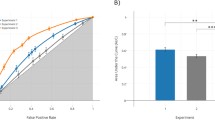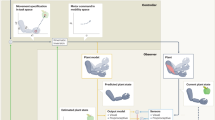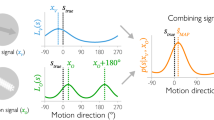Abstract
This report describes two models of human behavior when detecting displacements of joints that allow one to compare and integrate findings from different proprioception tests in a quantitative way. Results from various tests have led to different and often conflicting conclusions about proprioceptive behaviors and their underlying neural mechanisms. However, it has been impossible to compare data and conclusions in any meaningful way due to lack of a suitable analytical framework to accommodate important differences in procedures used in the various tests. These models can provide one such framework. The models, developed using data from proprioception tests reported in the literature, describe how the amplitude and velocity of joint excursions, and the subject bias expressed as false alarm rate, affect the detectability of displacements of joints. Two models were needed to represent observed behaviors: one based on velocity signals alone (the velocity model) and the other based on both velocity and positional signals (the displacement-velocity model). To simulate the detection-decision process subjects used to determine whether a joint was displaced, we adapted strategies from signal detection theory. The models characterized reported behaviors from disparate proprioception tests remarkably well, requiring only 3 degrees of freedom in the velocity case, and 4 in the displacement-velocity case.
Similar content being viewed by others
References
Clark FJ, Burgess RC, Chapin JW, Lipscomb WT (1985) Role of intramuscular receptors in the awareness of limb position. J Neurophysiol 54:1529–1540
Clark FJ, Burgess RC, Chapin JW (1986) Proprioception with the proximal interphalangeal joint of the finger: evidence for a movement sense without a static-position sense. Brain 109:1195–1208
Ferrell WR, Craske B (1992) Contribution of joint and muscle afferents to position sense at the human proximal interphalangeal joint. Exp Physiol 77:331–342
Gandevia SC, McCloskey DI (1976) Joint sense, muscle sense, and their combination as position sense, measured at the distal interphalangeal joint of the middle finger. J Physiol (Lond) 260:387–407
Gandevia SC, Hall LA, McCloskey DI, Potter EK (1983) Proprioceptive sensation at the terminal joint of the middle finger. J Physiol (Lond) 335:507–517
Goldscheider A (1889) Untersuchen über den Muskelsinn. Arch Anat Physiol 3:369–502
Green DM, Swets JA (1974) Signal detection theory and psychophysics. Krieger, New York
Hall LA, McCloskey DI (1983) Detections of movements imposed on finger, elbow and shoulder joints. J Physiol (Lond) 335:519–533
Horch KW, Clark FJ, Burgess PR (1975) Awareness of knee joint angle under static conditions. J Neurophysiol 38:1436–1447
McNichol D (1972) A primer of signal detection theory. George Alien, London
Tanner WP Jr, Swets JA (1954) The human use of information. I Signal detection for the case of a signal known exactly. Trans IRE PG Inform Theory 4:213–221
Taylor JL, McCloskey DI (1990) Ability to detect angular displacements of the fingers made at an imperceptibly slow speed. Brain 113:157–166
Author information
Authors and Affiliations
Rights and permissions
About this article
Cite this article
Clark, F.J., Deffenbacher, K.A. Models of behaviors when detecting displacements of joints. Exp Brain Res 112, 485–495 (1996). https://doi.org/10.1007/BF00227954
Received:
Accepted:
Issue Date:
DOI: https://doi.org/10.1007/BF00227954




